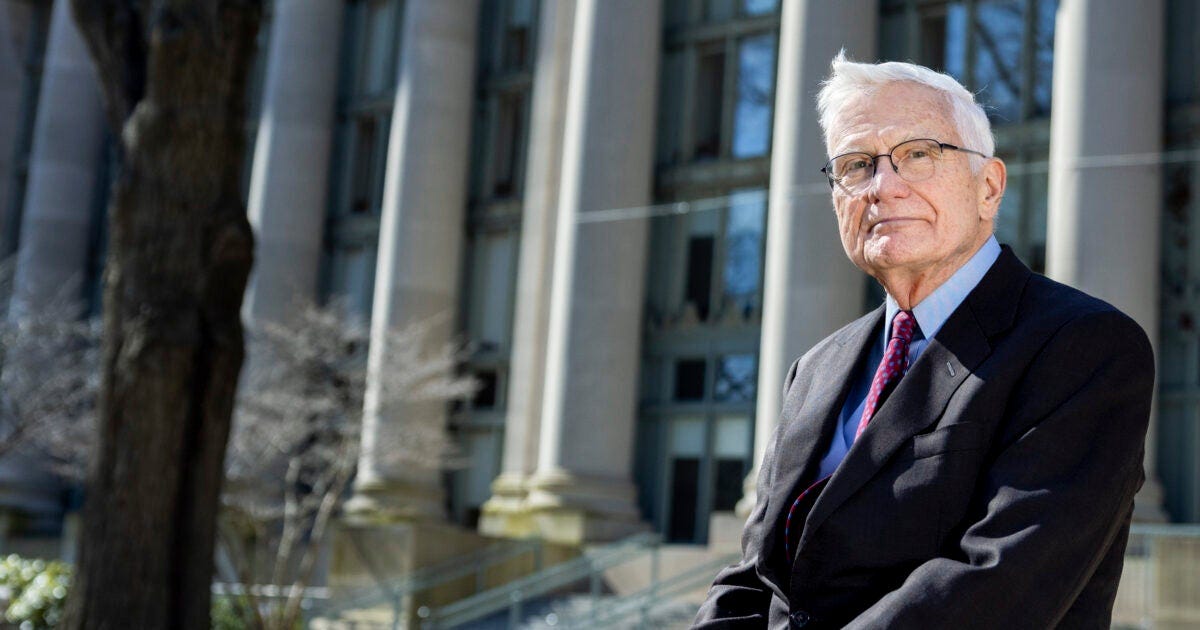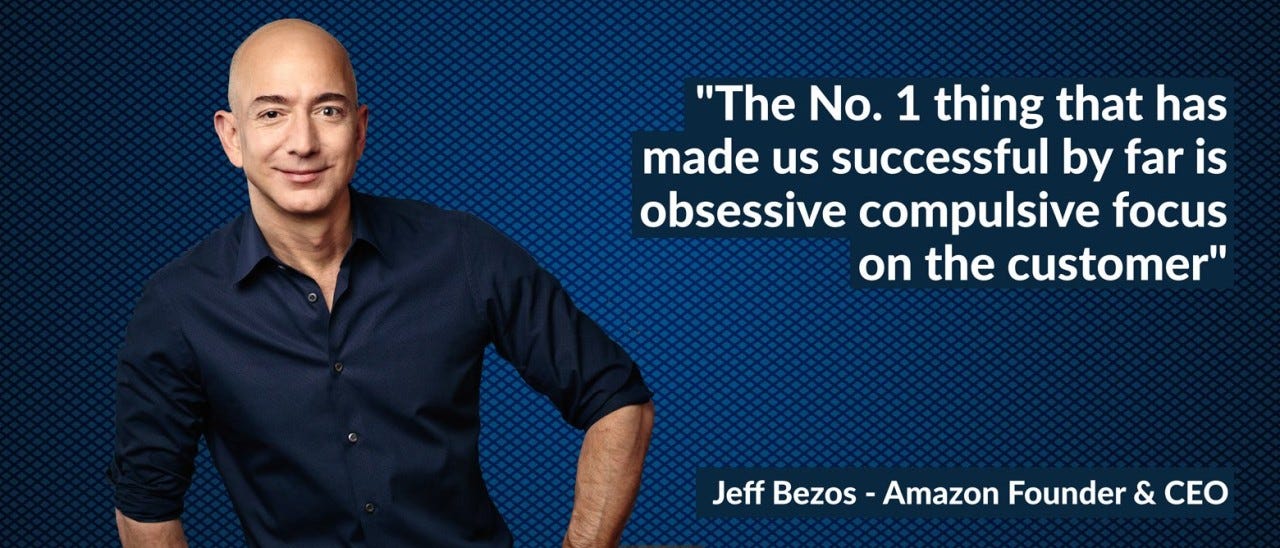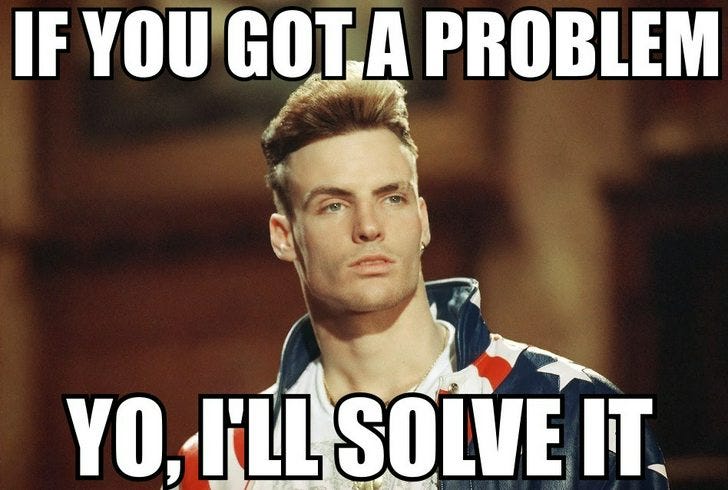The False Prophecies of More With Less
Enticing promises from shady figures appeal to dreams while creating nightmares
Beyond the shining city, a modest warren widened into a crater, then sank into a hole, its blank chasm puffing with the smoke and ashen cinders of whatever sat aflame deep beneath.
Knobbled knuckles of six calloused hands grasped the brim, their clenches hoisting three shadowy men onto the ground above, where they stood momentarily in brooding silence, brushing the dust from their garb.
Only a gentle hiss could be heard as they stepped in unison toward the city, dark clouds following above as if tethered. Behind them, a carriage seemed to move under its own steam, a golden glow brimming from its veil.
The ground closed behind them, foreclosing any return from whence they came. And as they drew nearer to the city walls, the cry of the watchman rang out as a beacon to anxious onlookers.
“Three strangers approach now, strange names scrawled on cloths affixed to their chests. Behind them moves a wagon train full of gold and set before the horse pushing it.”
Their knuckles rapped the oaken gate, which creaked open. The men entered the city, their gold in trail. Friendly grins and earnest nods greeted the men as they began to speak, the humble and spellbound welcome of modest people.
A sudden crackle of thunder straightened lips and silenced voices, a void soon filled by the discordant shrillness of the three prophets trumpeting what could only be taken as nonsense. Inscrutable jargon upon strange and groaning wavelengths. Relentless, everywhere.
And from then, false prophecies raged and swirled, carried upon a deafening whirlwind. Madness seized every townsman, confusion filling ears with a dissonant ring.
As the wind waned and the dust settled, horror’s hammer struck the anvil of mayhem. The grain stores had been emptied, the foundry had gone cold, and the wells were drawn dry.
Its walls rubble and riches gone, the town lay ruined. The false prophets had disappeared, along with their gold, leaving only an empty cart set before an idle horse.
And the clouds they dragged with them hovered overhead, pissing down with rain, never again to lift.
Timmy America: "Mom, how does paying taxes work?"
Mom: "Great question. Here's the bag of M&Ms you earned doing chores. Let's pretend I'm the government. You’re required to give me some of your M&Ms. I know exactly how many. You have to guess how many. If you give me more than required, I'll keep the extras. If you give me less, you’ll go bankrupt, lose your job, and go to prison. That's it."
Except it's actually much worse, because the government takes a cut of your candy up front and then you have to lobby to get back what was yours all along.
But this is a decent heuristic. It was the device of a brilliant law professor, though I expect he’d lifted it from a wily mom. That professor was Alvin Warren, who taught Taxation at Harvard.
On the first day of most law school classes, it’s a straight-into-the-deep-end process of analyzing and being grilled on particular cases and points of law. If you’ve ever watched The Paper Chase or absorbed Scott Turow’s book 1L, the depictions are realistic.
Warren took a different approach. He knew students were coming to his course with practical curiosities. Sure, they wanted to learn tax law. But they also wanted to unravel absurdities, sound smarter at cocktail parties, and dazzle family members with Yoda-esque insight.
So Warren elicited questions before the first day. Then sardonically whipped through terse but insightful responses for the first 30 minutes of class. His answers planted the seeds of new questions, breeding semester-long curiosity while de-cluttering minds. It was a brilliant tactic.
Two examples I still remember:
Q. Why is the tax process so frustrating?
A. “Because it's not built for you. But also because Congress doesn’t want you to like it."
The tax code transfers money from your wallet to the wallets of others, legally. Along the way, it champions and dissuades various things empowered agenda-setters wish it to. All under a patina of taxation as an evil necessity for a republic born resentful of it (in popular legend, anyway).
Q. Why doesn’t the process get reformed if that’s what Americans want?
A. “Because it’s serving a lot of interests the way it is.”
Imagine how many tax software companies, lawyers, advisors, financial planners, auditors, accountants, and various others who'd have to find something else to do if it got streamlined.
A simplified tax code would make it a lot more difficult for legislators and lobbies to engineer advantages, and it would also instantly kill countless cottage industries dependent on its complexity for their revenues.
Yes, that’s corrupt. Yes, it’s the definition of bureaucratic pathology in a national culture which lays claim to hatred of the very thing. And yes, it’s all done in the name of the American public, on their behalf, and quite often contrary to their interests.
Which makes taxation akin to countless other elements of contemporary life in a time of dissonance. Much of that dissonance is politically generated. But much more is garden variety, a necessary encumbrance of living and working in any organization big enough to accomplish anything. Because with that size comes pathologies as persistent as they are insidious, requiring ever-vigilant and proactive countermeasures.
When I confront the tax process each year, it triggers broader thoughts. About the snake oil we buy, about the false prophets who succeed in hocking it to us, and about the misery we create by simply pooling and actuating human nature without appropriate and healthy paranoia concerning the hazards of collective action.
The false prophets introduced earlier are restless raiders of organizations. Their names are Rationality, Simplicity, and Process. They promise improvement and deliver ruin.
I’ve yet to see an organization of any size, purpose, or composition resist their charms.
Let’s understand them by considering three things I propose, which I’ll try to persuade you are principles.
Rule1️⃣: Rational ≠ Logical.
A process is rational if it is purpose-built to serve the interests of the organization as defined by those in charge.
It's irrational if it undermines the organization. Interests tend to be quantifiable, and usually financial.
But when we apply a rational process to a large group of people and then adjust and tweak it to make it work, it can quickly become cumbersome, convoluted, and illogical for those confronting it. The illogic is all the more maddening when process inventors and process customers do not share the same interests.
Example: the military services adopted the Defense Travel System (DTS) for the rational purpose of reducing financial support staffing and associated costs.
This meant turning every traveling servicemember into an amateur, self-service travel agent. That doesn't sound so bad, right?
But to make it suit every travel scenario, the software had to be exceptional. It wasn't. To make the process frictionless for the busiest servicemembers (because that's who travels), it needed to be fast and intuitive. It was slow and clunky.
And to meet legal and regulatory requirements, the process needed validators and auditors who faced official consequences for getting their jobs wrong. This meant training trigger pullers to become qualified financiers.
The process unraveled as a horror show, demoralizing units who had no interest in self-supporting official travel, which created a compound penalty at the busiest moments.
There was nothing logical about it. But it was rationalized time and again by the savings of cutting force structure.
Rule 2️⃣: Simple ≠ Easy.
Simplicity just means there are defined steps in a process. It means the need to extemporize or to exercise situational judgement is minimized or removed.
As a mechanic repairing Air Force F-15s in my tender years, I completed steps in checklists and followed defined procedures outlined in technical orders. It was simple.
But there's nothing easy about changing an engine or replacing a hydraulic actuator wedged into a tight space deep within a fuselage.
Organizations often fool themselves by believing (or actively pretending) that simplifying a process justifies reducing the resources committed to it. If the process still requires specialized skills and experience levels, this can backfire, which then triggers the doubly expensive need to roll back changes.
In my time at Amazon, the operations network codified a simple process for checking in trucks arriving at gatehouses to deliver goods. This became the reason to remove Amazon associates from gatehouses and replace them with contract security teams.
It didn't work. Because having a checklist doesn't make it easier to engage with impatient drivers who may not speak your language. It doesn't reduce the pressure that comes with managing an overgrown queue. It doesn't remove the need to communicate with adjacent teams to orchestrate safe movements and de-conflict departures and arrivals.
Experience, training, and robust staffing are the only levers capable of easing a simple but difficult process.
See also the US Air Traffic Control system for a thousand more examples of resource and training reduction under the false pretense of simplicity, sometimes with tragic consequences.
And if you want a prediction, watch for the US Air Force to reverse its drastic reduction of pilot training hours, which has been touted as smart simplification. It's actually a desperate play to reduce costs, and will eventually be listed as causal and/or contributing in bad and likely smoldering consequences.
Rule 3️⃣: Process as Proxy Doesn't Work.
I learned something critical managing teams at Amazon. As a bonus, the company showed me both positive and negative examples to fully illustrate it.
It's a principle by which we can clearly distinguish between the Amazon of Jeff Bezos ("Bezozon") and the Amazon of Andy Jassy ("Jassazon").
Bezozon was an imperfect but endearing company with a clear sense of itself. As a place to work, it was always tough but seldom toxic. Difficult but rewarding, with material gain and professional growth the best you'd find anywhere. Best of all, there was a value system providing a sense of unity from end-to-end.
The calling card of Bezozon was Customer Obsession. It was the distinctive offering of a company that knew it would diversify, but also knew online retail would remain the engine of its revenue structure.
Retail is the funnel for Prime subscriptions, which is not only the key to repeat business but the magnet for third party sellers and the fees they pay. It's also the foundation for Prime Video, which is the carrier for ad revenue.
To keep that engine turning, Bezozon gave it four solid mounts. Fast delivery, huge selection, low prices, and exceptional customer service. It was understood that loosening or removing any of these mounts might cause the engine to vibrate and sputter.
Long-time customers will quaintly recall the positive experience of that legacy model. You might call it the Vanilla Ice customer service model.
Dial a number. Speak to a human within seconds. Explain your problem. Receive a remedial solution in minutes. Hang up. Smile. Brag to your friends. Go back to the website and order something else.
That model was built to sustain a relationship between company and customer. It relied upon employees with best-in-class training who were well-compensated, positively engaged, and retained. They were trusted to make decisions balancing business need and customer outcome, and further empowered to resolve close calls in favor of customers.
In Bezozon, it was understood that customer service resources were untouchable. The division did not report nearly as many metrics as others. There was no point, because all that mattered was customer loyalty.
Jassazon inherited a business that had tripled in scale in seven years and exploded its retail revenue during the pandemic. Faced with the cost challenge of having overbuilt capacity in recent years, Jassazon set about rationalizing every segment of the company (there’s that word). Customer obsession was replaced by cost obsession.
Someone decided that customer service was no longer untouchable, and indeed no longer a conduit for remaining attuned to customer sentiment through human relationships. The activity was mapped and scrutinized.
What emerged was a process. Reportable metrics multiplied. One-to-one phone calls were replaced by chats permitting one agent to handle multiple customers, albeit much more slowly. Detailed directives clarified if and how customers would receive concessions, removing those decisions from human agents. Approval authority was lifted to managers.
Many agents were replaced by semi-automated and AI-driven bots designed to push customers away from more expensive human interaction. Dissuasion tactics sought to frustrate and wait out all but the most determined complainers. And as the experience of being a customer service agent degraded, turnover increased within a labor pool already decimated by layoffs. This led to less capable agents and a further impaired experience for customers seeking remedies.
While it remains impressively rare to receive the wrong item, a damaged item, or a shipment so late it's no longer relevant, it does happen. And the process of dealing with Amazon is far less enjoyable when it does.
Navigate a menu maze to get past automated fob-offs and be presented a contact option, usually a chat. Invest at least a half an hour, most of it waiting for an agent to respond after you've given a yes/no answer to their previous question (because they're talking to several other customers in parallel).
Be told there is no remedy, or be offered a half-assed remedy that leaves a hole in your wallet. And as a final gratuitous slap, be given a choice between an instant refund to your Amazon account or a delayed refund to your bank account, a cynical tactic to dissuade customers from taking their business elsewhere.
The customer service process is a proxy for a customer relationship. And the problem with this is two-fold.
First, it degrades the relationship until neither side is empathizing with the other, which dilutes the experience for customers and stupefies the company into getting things wrong more often.
Instead of being focused on the relationship, Amazon is only concerned with subscriber numbers, which imply levels of satisfaction.
This leaves one of the four mounts loose and wobbly, making the model more reliant on the remaining three. With loyalty no more, any ripples in selection, price, or speed are now capable of triggering a mass customer defection.
Second, once the process becomes the thing, it's where executives and managers focus. It's where financiers dig for coins. This leads to a continual squeeze which carries activity further away from its value basis until it is completely disoriented from that basis. The "why" dissolves, replaced by the universal and uninspiring motive of cost savings. It’s uninspiring because employees don’t see any benefit from saving on costs. Nor any penalty from failing to do so.
This is a common plot point in the demise of many companies. If you build your identity on something and then kill it, you lose track of who you are as an organization. It takes exceptionally skilled and culturally savvy leadership to navigate a change of organizational identity. Jassazon doesn't have and isn't even trying to develop it.
One way to think about improving the things we care about -- companies, personal relationships, institutions -- is in terms of how we can reduce the number of "make it make sense" absurdities encountered when dealing with it.
Where we notice absurdities so common, so entrenched, and so darkly comical they make us berserk, we can almost always find a misguided attempt at top-down rationalization, a false equivalency between simplicity and ease, or an attempt to use process as a proxy for human relationships.
Logic, ease, and linear order are appealing ideas. We want to believe we can skip past tedium and get straight to slaying level bosses with exclusive cheat codes.
But we end up with nightmares rather than dreams coming true. Nature has a way of punishing us for shortcuts, and the reckoning can be rueful.
I made the false prophets in this vignette faceless because they arrive in many guises. Executives, consultants, champions of innovation. Or sometimes, just ordinary cog-level denizens who are pushing for promotion or fighting to secure their jobs.
The universal tactic of false prophets is the promise of more via the investment of less. This is only ever true in moments of technological discontinuity or innovative breakthrough. At all other moments, it’s an invitation to your own material and emotional fleecing. Someone might gain, but it won’t be you. So when you spot one of these critters, grab your wallet.
And then double down on the mundane commitment of improving things a little every day instead of reaching for a “big win.”
It ain’t sexy. But it’s less likely to break your heart.
Tony is a lifetime leader who has commanded military units and held senior roles in private sector operations. He is now an independent writer and expert voice on organizational leadership, management, operations, and national defense.
















